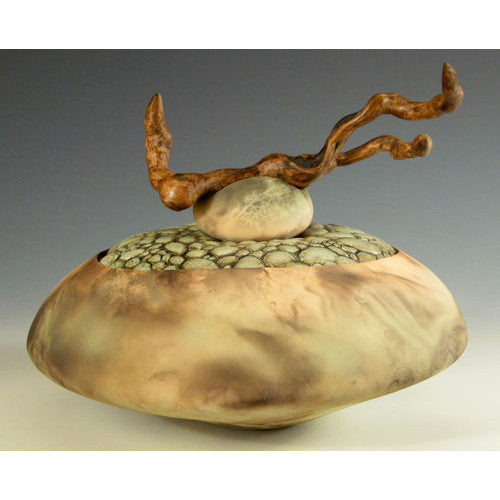
Jan Jacque
 “I explore the idea of tranquility, balance and complexity as manifested in nature with my clay and wood," Jan Jacque says. "I have always been drawn to the forms, lines, asymmetries and delicate intricacies found in nature. Nature inspires me endlessly. Clay subtly implies earth. Wood and plant images reflect the growth of living things. The vessels resulting from my lifelong study are the result of my careful balance of these elements. Slow, complex, infinitely fascinating.”
“I explore the idea of tranquility, balance and complexity as manifested in nature with my clay and wood," Jan Jacque says. "I have always been drawn to the forms, lines, asymmetries and delicate intricacies found in nature. Nature inspires me endlessly. Clay subtly implies earth. Wood and plant images reflect the growth of living things. The vessels resulting from my lifelong study are the result of my careful balance of these elements. Slow, complex, infinitely fascinating.”
Jan's creative process begins with a walk in the woods. She gathers fallen branches, studying them to find the form that speaks to her. She then makes drawings to capture what she envisions before cutting the branch down to a more manageable size.
The clay form is built from slabs and coils of fine textured white clay. It's then paddled, scraped and sanded until very smooth. The branch is worked into the clay vessel and then removed while the clay dries and shrinks.

Once complete, vessels are airbrushed with colorants and bisque fired in an electric kiln. Matte glazes are then applied and the piece is fired a second time. The third firing happens in a firing pit – a large metal box
filled with combustibles, pots, fire and smoke. Pots are packed in a collection of hardwood sawdust, leaves and straw.
Jan manages the fire, creating a very smoky atmosphere in the kiln which penetrates the clay. Different combustibles leave markings on the surface, called flashing.
Once the clay is fired, the original wood is sanded and carved to fit to the vessel. Finish-sanded, stained, lacquer sealed and affixed permanently to the vessel.
 In some vessels, it looks like the clay body has grown around the sanded branch. In others, the branch seems to grow out of the clay. The elements look like they belong together – like they've always been a part of each other.
In some vessels, it looks like the clay body has grown around the sanded branch. In others, the branch seems to grow out of the clay. The elements look like they belong together – like they've always been a part of each other.
